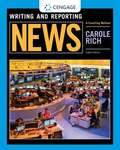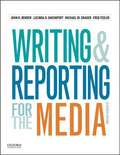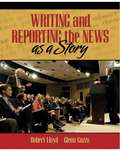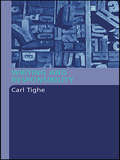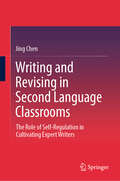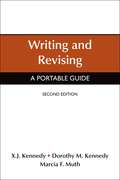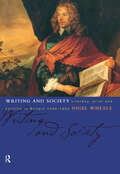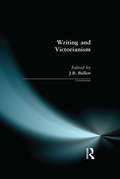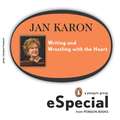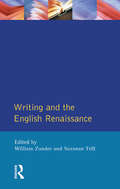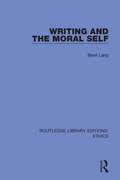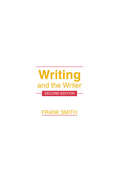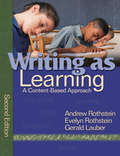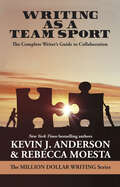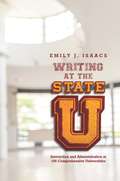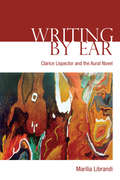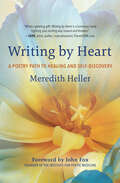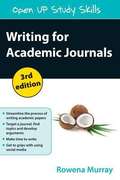- Table View
- List View
Writing and Reporting News: A Coaching Method
by Carole RichPulling examples straight from recent headlines, WRITING AND REPORTING NEWS: A COACHING METHOD, 8e uses tips and techniques from revered writing coaches and award-winning journalists to help you develop the writing and reporting skills you need to succeed in the changing world of journalism. Full-color photographs and a strong storytelling approach keep you captivated throughout the book. <P><P>An entire chapter is devoted to media ethics, while ethical dilemmas in each chapter give you practice working through ethical issues before you face them on the job. Offering the most up-to-date coverage available, the Eighth Edition fully integrates multimedia content into the chapters-reflecting the way the news world actually operates. It also includes an all-new book glossary featuring many of the newer terms used in Journalism. Integrating new trends in the convergence of print, broadcast, and online media, WRITING AND REPORTING NEWS equips you with the fundamental skills you need for media careers now-and in the future.
Writing and Reporting for the Media, Eleventh Edition
by John R. Bender Lucinda D. Davenport Michael W. Drager Fred FedlerA fundamental introduction to news writing and reporting, this classic text focuses on the basics of reporting, including critical thinking, thorough reporting, excellent writing and creative visual communication skills for stories across all media, and continues to be a top resource for journalism courses.
Writing and Reporting the News as a Story
by Robert Lloyd Glenn GuzzoFilled with current examples and tips from Pulitzer-Prize winning professionals, Writing and Reporting News as a Story teaches modern news writing skills while providing timely advice on ethics and career advancement. As a result of the outstanding professional experience of the author team and their devotion to teaching, this new text offers practical and real guidance to readers truly interested in a future in journalism.
Writing and Representation in Medieval Islam: Muslim Horizons (Routledge Studies in Middle Eastern Literatures #11)
by Julia BrayWith contributions from specialists in different areas of classical Islamic thought, this accessible volume explores the ways in which medieval Muslims saw, interpreted and represented the world around them in their writings. Focusing mainly on the eighth to tenth centuries AD, known as the ‘formative period of Islamic thought’, the book examines historiography, literary prose and Arabic prose genres which do not fall neatly into either category. Filling a gap in the literature by providing detailed discussions of both primary texts and recent scholarship, Writing and Representation in Medieval Islam will be welcomed by students and scholars of classical Arabic literature, Islamic history and medieval history.
Writing and Responsibility
by Carl TigheIn a world where literary scandals often end up in court, the issue of responsibility in writing has never been more important. In this groundbreaking study, Carl Tighe asks the questions every writer needs to consider: *What is it that writers do? Are they responsible for all the uses to which their writing might be put? Or no more responsible than their readers?*How are a writer's responsibilities compromised or defined by commercial or political pressures, or by notions of tradition or originality?*How does a writer's audience affect their responsibilities? Are these the same for writers in all parts of the world, under all political and social systems? The first part of this book defines responsibility and looks at its relation to ideas such as power, accuracy, kitsch and political correctness. The second part examines how particular writers have dealt with these issues through a series of often-controversial case studies, including American Psycho, Crash and The Tin Drum. Writing and Responsibility encourages its readers to interrogate the choices they make as writers. A fascinating look at the public consequences of the private act of writing, Carl Tighe's book is a must-read for everyone who writes or studies writing.
Writing and Revising in Second Language Classrooms: The Role of Self-Regulation in Cultivating Expert Writers
by Jing ChenThis book contributes to the field of L2 writing, with a focus on instruction in revision. Theoretically, this research provides a better understanding of students’ metacognitive knowledge about revision and their self-efficacy for text revision in EFL writing; such understanding is vital to make pedagogical connections between cognitive research, self-efficacy theory and instructional research in writing. Moreover, the designed questionnaire for data collection and analysis in this study can be employed as a diagnostic or consciousness-raising tool in the L2 writing classrooms or be used as a research tool to chart the development of students’ metacognitive knowledge about revision and self-efficacy for text revision over time to contribute to this line of research. Pedagogically, this study examined the effects of the SRSD model, an approach that has shown its effectiveness in improving learners’ metacognition and impacting their self-efficacy in both L1 and L2 writing, in the context of revision in an EFL context. Hence, it broadens the understanding of the feasibility and effectiveness of the SRSD model.
Writing and Revising: A Portable Guide (Second Edition)
by X. J. Kennedy Dorothy M. Kennedy Marcia F. MuthWriting and Revising can be used as a classroom text or as a quick reference, accommodating many different teaching needs. Whether students are developing brief papers or more complicated essays drawing on multiple sources, Writing and Revising encourages students, bolstering their confidence as they strengthen the skills necessary for writing projects in college and beyond.
Writing and Selling Your Mystery Novel Revised and Expanded Edition: The Complete Guide to Mystery, Suspense, and Crime
by Sara Paretsky Hallie EphronA Mystery Writers of America Edgar Award Finalist for Best Critical/Biographical Work Discover the secrets to crafting an unforgettable mystery! To piece together the puzzle of your mystery novel, you need patience, resilience, a solid understanding of the craft, and a clear blueprint for combining the plot, characters, setting, and more. And while patience and resilience must come from you, the essentials of craft and the plan to execute them are right at your fingertips with Writing and Selling Your Mystery Novel. This completely revised and updated edition features solid strategies for drafting, revising, and selling an intriguing novel that grips your readers and refuses to let them go.New York Times best-selling author Hallie Ephron shows you how to:Create a compelling sleuth and a worthy villainConstruct a plot rich in twists, red herrings, and misdirectionBring the story to a satisfying conclusionSharpen characters and optimize pace during revisionSeek publication through both traditional and indie pathsFilled with helpful worksheets and exercises for every step of the process, Writing and Selling Your Mystery Novel Revised and Expanded reveals the keys to writing a memorable story that will have fans of mystery, suspense, and crime clamoring for more.
Writing and Society
by Florian CoulmasHow does writing relate to speech? What impact does it have on social organisation and development? How do unwritten languages differ from those that have a written form and tradition? This book is a general account of the place of writing in society. Drawing on contemporary and historical examples, from clay tablets to touchscreen displays, the book explores the functions of writing and written language, analysing its consequences for language, society, economy and politics. It examines the social causes of illiteracy, demonstrating that institutions of central importance to modern society are built upon writing and written texts, and are characterised by specific forms of communication. It explores the social dimensions of spelling and writing reform, as well as of digital literacy, a new mode of expression and communication posing novel challenges to the student of language in society.
Writing and Society: Literacy, Print and Politics in Britain 1590-1660
by Nigel WhealeWriting and Society is a stunning exploration of the relationship between the growth in popular literacy and the development of new readerships and the authors addressing them. It is the first single volume to provide a year-by-year chronology of political events in relation to cultural production.This overview of debates in literary critical theory and historiography includes facsimile pages with commentary from the most influential books of the period. The author describes and analyses:* the development of literacy by status, gender and region in Britain* structures of patronage and censorship* the fundamental role of the publishing industry* the relation between elite literary and popular cultures* and the remarkable growth of female literacy and publication.
Writing and Victorianism (Crosscurrents)
by J. B. BullenWriting and Victorianism asks the fundamental question 'what is Victorianism?' and offers a number of answers taken from methods and approaches which have been developed over the last ten years. This collection of essays, written by both new and established scholars from Britain and the U.S.A, develops many of the themes of nineteenth-century studies which have lately come to the fore, touching upon issues such as drugs, class, power and gender. Some essays reflect the interaction of word and image in the nineteenth-century, and the notion of the city as spectacle; others look at Victorian science finding a connection between writing and the growth of psychology and psychiatry on the one hand and with the power of scientific materialism on the other.As well as key figures such as Dickens, Tennyson and Wilde, a host of new names are introduced including working-class writers attempting to define themselves and writers in the Periodical press who, once anonymous, exercised a great influence over Victorian politics, taste, and social ideals. From these observations there emerges a need for self-definition in Victorian writing. History, ancestry, and the past all play their part in figuring the present in the nineteenth-century, and many of these studies foreground the problem of literary, social, and psychological identity.
Writing and Wrestling with the Heart: Jan Karonfs Washington National Cathedral Lecture
by Jan KaronIn this Penguin eSpecial, Jan Karon, the bestselling author of the Mitford and Father Tim novels, tells the personal story of her life as a writer. Illuminating the way in which faith has influenced both her life and her writing, Karon also discusses her calling as an author--a calling she received early but took years to answer. Only an incredible leap of faith gave her the courage to give up all she had, risking everything to follow this call. Intimate, funny, and straight-from-the-heart, this eSpecial is a superb companion to Jan Karon's novels, providing a revealing glimpse into the life of a novelist who has moved so many people with her words.
Writing and the Ancient State
by Wang HaichengWriting and the Ancient State explores the early development of writing and its relationship to the growth of political structures. The first part of the book focuses on the contribution of writing to the state's legitimating project. The second part deals with the state's use of writing in administration, analyzing both textual and archaeological evidence to reconstruct how the state used bookkeeping to allocate land, police its people, and extract taxes from them. The third part focuses on education, the state's system for replenishing its staff of scribe-officials. The first half of each part surveys evidence from Mesopotamia, Egypt, the Maya lowlands, Central Mexico, and the Andes; against this background the second half examines the evidence from China. The chief aim of this book is to shed new light on early China (from the second millennium BC through the end of the Han period, ca. 220 AD) while bringing to bear the lens of cross-cultural analysis on each of the civilizations under discussion. The compiling of lists - lists of names, or of names and numbers - is a recurring theme throughout all three parts. A concluding chapter argues that there is nothing accidental about the pervasiveness of this theme: in both origin and function, early writing is almost synonymous with the listing of names.
Writing and the English Renaissance (Crosscurrents)
by William Zunder Suzanne TrillWriting and the English Renaissance is a collection of essays exploring the full creative richness of Renaissance culture during the sixteenth and seventeenth centuries. As well as considering major literary figures such as Spenser, Marlowe, Donne and Milton, lesser known - especially women - writers are also examined. Radical writing and popular culture are considered as well. The scope of the study not only extends the parameters for debate in Renaissance studies, but also adopts a radical interdisciplinary approach, bridging the gap between literary, historical, cultural and women's studies, leading to a much fuller picture of life in the sixteenth and seventeenth centuries.The authors discussed are placed in their full historical and literary context, with an extensive selection of original documentation included in the text - for example, from The Book of Common Prayer or the Homilies to contextualize the writing under discussion. This distinctive approach, combined with a detailed chronology of the period and bibliography, embracing both canonical and non-canonical writers, makes this volume a unique reference resource and course reader for Renaissance studies.
Writing and the Moral Self
by Berel LangOriginally published in 1991, this book analyses the relation between writing and ethics in a number of social contexts – in politics, as language discloses its connections to the institutions of totalitarianism and democracy; in the university, as contemporary scholarly ideals find an uncomfortably accurate representation in the stylistic forms of academic writing; in daily social practice, ranging from the status of truth in journalistic writing to the connection between pronouns and affirmative action; and finally in the ethical structure of language itself.
Writing and the Writer
by Frank SmithExploring the relationship between the writer and what he/she happens to be writing, this text by one of the foremost scholars in the field of literacy and cognition is a unique and original examination of writing--as a craft and as a cognitive activity. The book is concerned with the physical activity of writing, the way the nervous system recruits the muscles to move the pen or manipulate the typewriter. It considers the necessary disciplines of writing, such as knowledge of the conventions of grammar, spelling, and punctuation. In particular, there is a concern with how the skills underlying all these aspects of writing are learned and orchestrated. This second edition includes many new insights from the author's significant experience and from recent research, providing a framework for thinking about the act of writing in both theoretical and practical ways. A completely new chapter on computers and writing is included, as well as more about the role of reading in learning to write, about learning to write at all ages, and about such controversial issues as whether and how genre theory should be taught. Written in nontechnical language, this text will continue to be accessible and stimulating to a wide range of readers concerned with writing, literacy, thinking, and education. Furthermore, it has an educational orientation, therefore proving relevant and useful to anyone who teaches about writing or endeavors to teach writing.
Writing as Learning: A Content-Based Approach
by Andrew S. Rothstein Evelyn B. Rothstein Gerald LauberUsing 12 step-by-step strategies, teachers can help students build a rich vocabulary, gain a deep understanding of concepts, and develop organized thinking processes.
Writing as a Team Sport: The Complete Writer's Guide to Collaboration (Million Dollar Writing Series)
by Kevin J. Anderson Rebecca MoestaIn a creative project, are two heads better than one? Writing partnerships can produce a remarkable synergy, building on each other&’s talents to create work unlike anything the individual authors could do alone. On the other hand, unsuccessful collaboration can be disastrous and has ruined many a friendship. Kevin J. Anderson has worked on numerous novels and stories with dozens of collaborators, and many of those projects have become bestsellers and award winners. Rebecca Moesta has written books and stories with numerous other writers. In this in-depth book Anderson and Moesta describe various collaboration methods with frank recollections of their own experiences. You&’ll learn collaborative techniques that will suit any sort of writer, as well as the pitfalls you may encounter. Includes a sample collaboration agreement to adapt to your own needs.
Writing as a Way of Healing: How Telling Our Stories Transforms Our Lives
by Louise DesalvoIn this inspiring book, based on her twenty years of research, highly acclaimed author and teacher Louise DeSalvo reveals the healing power of writing. DeSalvo shows how anyone can use writing as a way to heal the emotional and physical wounds that are an inevitable part of life. Contrary to what most self-help books claim, just writing won't help you; in fact, there's abundant evidence that the wrong kind of writing can be damaging. <P><P> DeSalvo's program is based on the best available and most recent scientific studies about the efficacy of using writing as a restorative tool. With insight and wit, she illuminates how writers, from Virginia Woolf to Henry Miller to Audre Lorde to Isabel Allende, have been transformed by the writing process. Writing as a Way of Healing includes valuable advice and practical techniques to guide and inspire both experienced and beginning writers.
Writing at Russia's Borders
by Katya HokansonIt is often assumed that cultural identity is determined in a country?s metropolitan centres. Given Russia?s long tenure as a geographically and socially diverse empire, however, there is a certain distillation of peripheral experiences and ideas that contributes just as much to theories of national culture as do urban-centred perspectives. Writing at Russia?s Border argues that Russian literature needs to be reexamined in light of the fact that many of its most important nineteenth-century texts are peripheral, not in significance but in provenance.Katya Hokanson makes the case that the fluid and ever-changing cultural and linguistic boundaries of Russia?s border regions profoundly influenced the nation?s literature, posing challenges to stereotypical or territorially based conceptions of Russia?s imperial, military, and cultural identity. A highly canonical text such as Pushkin?s Eugene Onegin (1831), which is set in European Russia, is no less dependent on the perspectives of those living at the edges of the Russian Empire than is Tolstoy?s The Cossacks (1863), which is explicitly set on Russia?s border and has become central to the Russian canon. Hokanson cites the influence of these and other ?peripheral? texts as proof that Russia?s national identity was dependent upon the experiences of people living in the border areas of an expanding empire. Produced at a cultural moment of contrast and exchange, the literature of the periphery represented a negotiation of different views of Russian identity, an ingredient that was ultimately essential even to literature produced in the major cities.Writing at Russia?s Border upends popular ideas of national cultural production and is a fascinating study of the social implications of nineteenth-century Russian literature.
Writing at the State U: Instruction and Administration at 106 Comprehensive Universities
by Emily IsaacsWriting at the State U presents a comprehensive, empirical examination of writing programs at 106 universities. Rather than using open survey calls and self-reporting, Emily Isaacs uses statistical analysis to show the extent to which established principles of writing instruction and administration have been implemented at state comprehensive universities, the ways in which writing at those institutions has differed from writing at other institutions over time, and how state institutions have responded to major scholarly debates concerning first-year composition and writing program administration. Isaacs’s findings are surprising: state university writing programs give lip service to important principles of writing research, but many still emphasize grammar instruction and a skills-based approach, classes continue to be outsized, faculty development is optional, and orientation toward basic writing is generally remedial. As such, she considers where a closer match between writing research and writing instruction might help to expose and remedy these difficulties and identifies strategies and areas where faculty or writing program administrators are empowered to enact change. Unique in its wide scope and methodology, Writing at the State U sheds much-needed light on the true state of the writing discipline at state universities and demonstrates the advantages of more frequent and rigorous quantitative studies of the field.
Writing beyond Prophecy: Emerson, Hawthorne, and Melville after the American Renaissance
by Martin KevorkianWriting beyond Prophecy offers a new interpretation of the American Renaissance by drawing attention to a cluster of later, rarely studied works by Ralph Waldo Emerson, Nathaniel Hawthorne, and Herman Melville. Identifying a line of writing from Emerson's Conduct of Life to Hawthorne's posthumously published Elixir of Life manuscript to Melville's Clarel: A Poem and Pilgrimage in the Holy Land, Martin Kevorkian demonstrates how these authors wrestled with their vocational calling. Early in their careers, these three authors positioned their literary pursuits as an alternative to the ministry. By presenting a "new revelation" and a new set of "gospels" for the nineteenth century, they sought to usurp the authority of the pulpit. Later in life, each writer came to recognize the audacity of his earlier work, creating what Kevorkian characterizes as a literary aftermath. Strikingly, each author later wrote about the character of a young divinity student torn by a crisis of faith and vocation. Writing beyond Prophecy gives a distinctive shape to the late careers of Emerson, Hawthorne, and Melville and offers a cohesive account of the lingering religious devotion left in the wake of American Romanticism.
Writing by Ear: Clarice Lispector and the Aural Novel (University of Toronto Romance Series)
by Marilia LibrandiConsidering Brazilian novelist Clarice Lispector’s literature as a case study and a source of theory, Writing by Ear presents an aural theory of the novel based on readings of Near to the Wild Heart (1943), The Besieged City (1949), The Passion According to G.H. (1964), Agua Viva (1973), The Hour of the Star (1977), and A Breath of Life (1978). What is the specific aesthetic for which listening-in-writing calls? What is the relation that listening-in-writing establishes with silence, echo, and the sounds of the world? How are we to understand authorship when writers present themselves as objects of reception rather than subjects of production? In which ways does the robust oral and aural culture of Brazil shape literary genres and forms? In addressing these questions, Writing by Ear works in dialogue with philosophy, psychoanalysis, and sound studies to contemplate the relationship between orality and writing. Citing writers such as Machado de Assis, Oswald de Andrade and João Guimarães Rosa, as well as Mia Couto and Toni Morrison, Writing By Ear opens up a broader dialogue on listening and literature, considering the aesthetic, ethical, and ecological reverberations of the imaginary. Writing by Ear is concerned at once with shedding light on the narrative representation of listening and with a broader reconceptualization of fiction through listening, considering it an auditory practice that transcends the dichotomy of speech and writing.
Writing by Heart: A Poetry Path to Healing and Self-Discovery
by Meredith HellerWrite to Explore and Express the Wild Beauty of Your Heart Meredith Heller invites you to write as a path toward self-understanding and as a lifelong refuge of steadfast friendship with yourself. She used the power of writing to heal and save her own life, and now she teaches others to do the same. In this book, Meredith shares the techniques she developed to help people from all walks of life explore their emotions, find their voice, and better navigate life’s challenges. Filled with potent exercises and inspiring poems from the author and her students, Writing by Heart is a must-read for anyone, from seasoned writer to novice, who wants to discover the transformative power of writing.
Writing for Academic Journals
by MurrayWriting for publication is a daunting and time-consuming task for many academics. And yet the pressure for academics to publish has never been greater. This book demystifies the process of writing academic papers, showing readers what good papers look like and how they can be written. Offering a research-informed understanding of the contemporary challenges of writing for publication, this book gives practical advice for overcoming common obstacles such as finding a topic, targeting journals, and finding the time to write. The author offers a range of helpful writing strategies, making this an invaluable handbook for academics at all stages of their career, from doctoral students to early career researchers and even experienced academics. The third edition has been comprehensively updated to reflect the changing landscape of academic writing, including the most recent research and theory on writing across the disciplines. Drawing on her extensive experience of running writing workshops and working closely with academics on developing writing, Rowena Murray offers practical and tested strategies for good academic writing. New to the third edition: Advice on how to use social media to promote your publications More examples from different disciplines and journals More advice on how to tackle writer's block Extended end-of-chapter checklists New evidence that these strategies really work!
